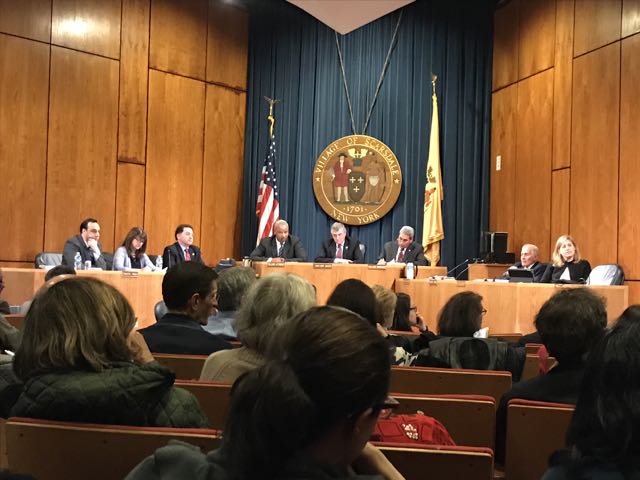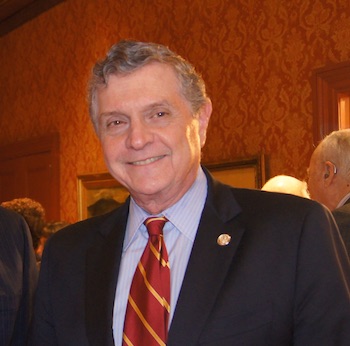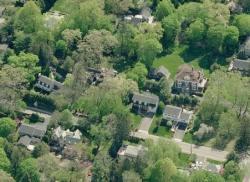Village Loses Two More Retailers
- Details
- Written by Joanne Wallenstein
- Hits: 7307
 The new year begins with the loss of two more stores in Scarsdale Village. Candy 'n Cards, marked 50 years in Scarsdale by announcing that it would close it's doors on January 31. The 99 year-old owner, Emily Hirsch is a Village treasure and celebrates her birthdays with a public celebration each June.
The new year begins with the loss of two more stores in Scarsdale Village. Candy 'n Cards, marked 50 years in Scarsdale by announcing that it would close it's doors on January 31. The 99 year-old owner, Emily Hirsch is a Village treasure and celebrates her birthdays with a public celebration each June.
Last June we asked her for her secret to longevity and here is what she advised:
- Get up everyday and go about your business
- Be happy
- Hopefully have good genes
Though Hirsch is beloved, she struggled to maintain sales recently and decided that now is the time to move on. Everything will be half off at the store until she closes on January 31, 2017.
Pure Raw Juice on Harwood Court, that offered juice blends and natural food snacks is also closing, leaving yet another vacant storefront downtown. Imagine Candy, also on Harwood Court closed in October after making a valiant effort to make a go of a profitable business in town.
As vacancies increase, it becomes more and more difficult for the existing stores to get enough street traffic. One successful retailer told Scarsdale10583 that he considered expanding his operation into the adjacent empty storefront. However, the landlord was unwilling to negotiate the rent, despite the fact that the space has been unoccupied for almost two years.
Is it time for Scarsdale landlords to reduce rents? With more reasonable rents, perhaps the Village can attract some mom and pop or individually owned stores, selling everyday necessities and food to attract buyers to Scarsdale. Frozen yogurt, stationary, small electronics, children's shoes plus a variety of restauranteurs would be welcome additions to town.
Library Project is a Go! Village Board Approves $9.9 MM Bond Offering
- Details
- Written by Joanne Wallenstein
- Hits: 6935
 Calling the proposed library renovation a right-sized project at the right time, the Scarsdale Village Board made history on Tuesday night 12-13 when they approved a $9.9 million bond offering to fund the "public" portion of the ambitious project which will update and expand Scarsdale's aging library. Trustee Bill Stern said the library was "The jewel in the crown of the community," and voted "yes" for the bond saying "We owe it to Scarsdale to make that crown shine." Plans call for a complete overhaul of the library that will open up the main reading room, add meeting spaces, install new wiring and technology, expand the children's and teen areas and include a café that will serve as a gathering place for the community.
Calling the proposed library renovation a right-sized project at the right time, the Scarsdale Village Board made history on Tuesday night 12-13 when they approved a $9.9 million bond offering to fund the "public" portion of the ambitious project which will update and expand Scarsdale's aging library. Trustee Bill Stern said the library was "The jewel in the crown of the community," and voted "yes" for the bond saying "We owe it to Scarsdale to make that crown shine." Plans call for a complete overhaul of the library that will open up the main reading room, add meeting spaces, install new wiring and technology, expand the children's and teen areas and include a café that will serve as a gathering place for the community.
The vote marked the culmination of six years of planning by Scarsdale Library Board of Trustees, who began the process with focus groups and an assessment of community needs. Non-profit consultants Plan A Advisors were retained to evaluate the potential for private fundraising. Schematics were drawn to address these needs and allowed the board to get estimates of what it would cost to take the library into the 21st century.
The group overcame major obstacles, specifically fierce objections to the 2016 Revaluation that consumed almost all of the Village Board's attention for the better part of a year and brought out a cost-conscious segment of the community who railed against higher taxes and public spending. Ultimately the Library Board managed to re-position the proposed library renovation as the answer to the Village's woes, switching the focus from taxes to investment in the community. They communicated the concept of a 21st century cultural and intellectual hub that would serve all residents from tots to seniors, now and for future generations.
When the Village Board proposed putting the bond offering to a community-wide referendum, the group advocated for the Village Board to use their authority to make the decision themselves. Perhaps they feared that a Village-wide vote might incite a backlash, similar to a movement that brought the first negative school budget vote in Scarsdale in 2013. At the meeting on Tuesday night, trustees voted down a resolution to put the bond offering to a village-wide vote.
Undoubtedly a key piece of the group's success was their ability to attract a large and capable group to their team, who reached out to the community at large, were a constant presence at Village Hall and were flexible in addressing criticisms. In response to objections to the original $20.5 million project, they identified $3 mm in cost savings in July 2016, bringing the cost down to $17.9 million.
The Library Capitol Campaign Committee has pledged to raise a total of $7.5 million and they have already met $4.1 million of that goal. At the meeting on Tuesday, Dara Gruenberg, who heads the Campaign Committee, made a surprise announcement that they had secured two major donations of $1 million each, contingent upon the Village Board's approval of the bond. That $2 million puts them at $4.1 million to date.
Funds will come from a variety of sources. Proponents pointed out that the Village Board had already approved $4.5 million for renovations to the existing building in 2014. They also believe that during the two years that the library will be closed there will be $1.5 million in operational cost savings to the Village. In addition, the Village Manager has also applied for a $500,000 grant from the NYS Dormitory Authority that will be used toward this project.
Under the terms of the resolution, private contributions will need to be secured before the Village issues the $9.9 million bond offering. The agreement says, "No bonds or notes shall be sold by the Village Treasurer pursuant to the authority delegated to the Village Treasurer here in unless and until an aggregate of $7,500,000 expected to be received from the Friends of the Library or other sources shall have been received by the Village Treasurer or are available from a Qualify Back-stop Facility."
Though the Library Board has now achieved this major hurdle, the Campaign Committee will still need to raise another $3.4 million to make the project a reality.
Commenting on the vote, Terri Simon, the President of the Board of the Scarsdale Library said, "The Library Board is so pleased by the vision and leadership shown by the Village Board in approving the $9.9 million bond resolution, a critical step toward making a 21st century library a reality for Scarsdale. The trustees worked immensely hard, as our elected representatives, asking us focused and challenging questions about project complexities for several years, and the project is the better for it. We appreciate their commitment now to moving forward in a way that will be good for all of Scarsdale. We are also immensely gratified by the outpouring of community support for the project, and we are confident that, with the Village commitment, we will be able to complete the private fundraising that will, with the benefit of this unusual public-private partnership, bring the project to fruition."
In a meeting that extended to midnight, each Trustee offered a lengthy explanation for their vote, which was six for and one against.
Jane Veron said that she "joined the board with no preconceived ideas about the library, but after lots of research I will support the project and vote no to a referendum." She continued, "The library is woefully inadequate. ... It would be irresponsible not to act now when we have private funds at the ready. The library is core to our brand. Families expect us to have a library like or better than like towns... Our community prides itself on engaged learning...We believe in the power of Scarsdale."
Matt Callaghan was the sole "no" vote on the board. He had reservations about securing the pledges and feared construction cost overruns that would be paid for by the Village. Instead, he favored funds going to the renovation of Fire Station #1, calling it a "life and death matter."
Bill Stern showed a photo of duct tape holding up a portion of a wall at the library. He said, "Keep the library in the 21st century. There is not enough space, not enough room and services are stymied. I think this is a godsend for the community. It will maintain Scarsdale's property values and make it attractive in the future."
Carl Finger acknowledged and thanked the public, saying, "It's been an education." He said this issue "Has had the most public participation of any in recent memory .... and there has been lots of research and involvement." He said, that "Circulation, attendance and events and usage have been increasing every year." Justifying the expense, he said, "The Village is getting the library at half the price" and it is "incumbent upon us to improve our village." He voted "yes."
Trustee Deb Pekarek concurred, remembered her experience with libraries as a child, a mother and a teacher. She said, "I can conjure up libraries all over the country and have visceral remembrances of past and present. " She called libraries places of "adventure and discovery," and said, "Now is the time to weigh the project we have before us." She said that "careful cost controls are in place," and voted yes.
Trustee Marc Samwick said he was originally skeptical of the plan but ultimately decided that the Village's net investment was only $4 million more than they would have paid for a renovation. He promised to "remain diligent as we move forward" and said he was "proud to vote in favor of this library that we will enjoy for decades to come."
Mayor Jon Mark call the Library Board "a driving force" and said the library had been on the agenda at 40 public meetings. He said, "libraries are very much in demand," and "are treated as a core function in communities large and small, adding, "There is no reason that Scarsdale should not act now." He quoted former Scarsdale School Superintendent Harold Howe (1960-64) who said, "What a school thinks about its library is a measure of what it feels about education" and said "The same can be said about a village. What we think about our library is a measure of what we feel about education in a broader sense here in Scarsdale. Now is a moment to show this is a core value and we are prepared to make an investment both for ourselves and those who come after us."
The Board voted 6-1 to approve the bond offering and voted unanimously against a public vote on the bond referendum. You can watch the meeting in its entirety here:
Residents Speak Out at Marathon Meeting About the Proposed Library Renovation
- Details
- Written by Joanne Wallenstein
- Hits: 7709
Residents crowded Village Hall on Tuesday 11-29 to express their views on a proposed $17.9 mm overahaul of the Scarsdale Library.
The lengthy conversation on Tuesday about the future of the library rallied hundreds of residents who crowded Village Hall, eager to express their views on a public/private partnership that would revamp the facility, create a community hub, make the building accessible to those with disabilities and upgrade facilities to reflect new trends in media usage. The $17.9 mm proposal calls for a $7.5 million capitol campaign with the balance funded by a $500,000 grant from New York State and a $9.9 million bond referendum from Scarsdale Village. Proponents note that the Village Board previously committed to spending $4.5 million for necessary infrastructure work to the aging building, and this additional spend would make the library the "intellectual and cultural hub of the Village for generations to come."
Introducing the discussion, Library Board President Terri Simon indicated a new library might be a cure for what ails the Village, saying, "...by bringing our library into the 21st century, we offer a positive, constructive path for Scarsdale to move forward from a challenging time, as a united community." She challenged the trustees to approve the funding and "leave a wonderful legacy for all of Scarsdale."
Library Director Elizabeth Bermel said that the committee had already raised $2mm and had commitments for another $1mm. She said that to date, all the plans and schematics were funded by contributions from donors and that they are optimistic that they can meet their fundraising target.
The Friends of the Scarsdale Library worked with Village personnel on the project and the Village Planner and Treasurer both made presentations to the group. Planner Elizabeth Marrinan said that there was adequate parking at the current library (110 spaces) to support the new building, in addition to adequate parking at Supply Field where a temporary library would be located during construction. Traffic experts analyzed traffic and found no anticipated impacts from the renovation.
Treasurer Mary Lou McClure reviewed the impact on Village finances of a proposed $9.9 million bond which would be repaid in 15 years. She did not anticipate that it would affect the Village's AAA bond rating, but warned about potential tax increases due to unfunded mandates for sanitary sewer replacements. The impact of the additional debt is estimated to be $137 per household per year, for 15 years.
During the discussion about finances, someone from the audience asked Terri Simon what would happen if the campaign failed to reach their fundraising goals. Simon said that "construction bid documents and plans will be done with design alternatives. We do not intend to come back for the taxpayers for more," (if they fail to raise the entire $7.5 million.)
Village Attorney Wayne Essanason explained the law as it relates to a vote on the bond referendum. If the Village Board decides to hold a general referendum and they adopt a resolution before January, the vote would need to take place before February 13, 2017. If the board adopts a resolution between January 1 and March 1, 2017, the vote on the referendum would take place during the general village election on March 21, 2017. The Board of Trustees can also approve the bond as a board, without calling for a general vote from residents.
During the course of the three and a half hour meeting, many residents spoke, both for and against the proposal. The meeting was recorded and you can watch it in its entirety here:
In short, Marian Green, Chair of the Council on People with Disabilities spoke about the importance of making the library handicapped accessible and compliant with provisions in the Americans with Disabilities Act.
Lisa Messinger supplied the board with a petition of the proposal with 600 signatures, which she said were "collected over a busy holiday weekend."
Mordechai Beizer did not find the estimate for operating the new library to be credible and believed that three more full time employees, at a total cost of $350,000- $400,000 a year might be needed. He feared a 30% increase in the annual budget of the library and also questioned why a café, outdoor reading deck, maker space and emergency generator were needed.
Library Director Beth Bermel explained personnel needs and said that only additional custodial staff would be required.
Felicia Block discussed, "wants" vs. "needs." She said the library would be an "investment in our community and our children," calling it "an extension of our schools and our homes." She said, "This is not just the want of a few, it is something that our entire Scarsdale family needs."
Jill Spielberg highlighted the importance of making the library accessible to those with special needs and said, "children deserve a library that is appropriate for this time.
Howard Blitman, a former trustee, asked that the project be done at "a price that makes sense." He said, "Yes we need a bathroom and an elevator," but "if we could save $3 to $4 million it would be more acceptable to the people of this village."
Mayra Kirkendall Rodriguez, who led the objection to the revaluation, said she had carefully analyzed the library report. She questioned whether there were contingencies in the budget for rising labor costs that could result if the government approves large infrastructure projects. She said, "no one can predict what will happen --- look at the tail risk. You are going to have a labor shortage." She suggested that President-elect Trump might deport undocumented immigrants resulting in a labor shortage. She also asked to see the formula used to project potential fundraising and asked how the Village could validate the construction estimates. She questioned why the Village had to be the "risk taker" in the public/private partnership.
Turning to the results of a recent survey by the Scarsdale Forum, Rodriguez suggested that the data showed that people were not informed about the library and did not think it needed to be renovated now. Scarsdale Forum VP M.L. Perlman came to the mike to correct Rodriguez saying that the purpose of the survey was to engage the public and that it had "high instances of bias" and was designed on an "amateur platform." She said it indicated that the majority of respondents do support a renovation either "someday" or "immediately."
The Mayor responded saying that he believed that the Village's contribution would be conditional upon the library campaign meeting certain targets, but it was clear that those details had not yet been worked out.
Lynne Clark said that the library is a "vital resource," that must be expanded "to meet the needs of little people and older people." She added, "A beautiful library will be a beacon of light to draw people to Scarsdale," and asked the Trustees not to hold a general referendum.
Mary Beth Evans read a lengthy statement in support of the library renovation from the League of Women Voters of Scarsdale that praised the committee on their fact finding, analysis and process. The League did raise questions about what could happen if private funding was slower than anticipated and there were "shortfalls during construction." She said, "The League does not support putting this to a public referendum. It is within the authority of the Village Board to make this decision."
Carrie Moskowitz objected to the scope and the cost of the project saying we are "already a highly taxed community." She called the project, "scope creep," reflecting a lack of concern about spending other people's money."
Bob Berg told the Board they must decide which comes first, "the chicken or the egg." He called on the Board to agree whether or not the Village's funding commitment would be conditional on the library board raising the$7.5 million in contributions first.
Kathy Steves, a librarian who chairs the annual book sale, told the Board that the library needs an elevator, not a dumbwaiter, as well as another meeting space to be used when the Scott Room is being used to set up and run the book sale.
Preeti Singh said, "The Library Board has smart people who have done their due diligence, and know what we need. I trust them."
Harriet Sobol urged the Board to commit themselves to the bond, rather than hold a general referendum.
Former Mayor Carl Pforzheimer answered concerns about closing the library during the renovations, saying that the New York Public Library had just decided to close the main library on 40th Street and 5th avenue for nearly three years while it is renovated. He urged to the board to modernize the building and to "not be satisfied with patching a 40 year-old design."
Library Board member Diane Greenwald said the plans for the library "hit the sweet spot; and are not too flashy or over the top." She reminded the Trustees that 600 people had signed a petition to support the plan.
Dara Gruenberg, also an integral player on the library committee said, "Scarsdale has a long and revered history of service and giving back to our town through both volunteerism and investment in our resources. Therefore, it is incumbent upon us, as residents who carry the mantle of those who came before us and invested in Scarsdale, to leave this town better than we found it."
The outpouring of comments from the community heartened the Village Board of Trustees. Trustee Deb Pekarek said, "This meeting lifted my spirits." Carl Finger said "This was the most enjoyable meeting I have attended in quite some time" and added, "I got a sense of how important the library is to the community." Jane Veron said it was "an honor to work in this community," and expressed her appreciation for the diligent work of the committee.
As the meeting concluded, Mayor Jon Mark said that the Board would have a regular meeting on December 13, 2016 when the conversation would be continued.
Free Parking, Tree Lighting and Breakfast with Santa in Scarsdale
- Details
- Written by Joanne Wallenstein
- Hits: 4275
 It's holiday time in Scarsdale Village. Events kick off with the tree lighting in Boniface Circle on Friday at 5, followed by breakfast with Santa at SHS on Saturday morning, and free parking in the Village from December 19 – 27. Come out and enjoy!
It's holiday time in Scarsdale Village. Events kick off with the tree lighting in Boniface Circle on Friday at 5, followed by breakfast with Santa at SHS on Saturday morning, and free parking in the Village from December 19 – 27. Come out and enjoy!
Christmas Tree Lighting:
The Scarsdale Christmas Tree will be lit on Friday December 9 at Boniface Circle at 5 pm. There will be a visit from Santa and a serenade from the Hoff-Barthelson carolers. Bring the kids to meet Santa.
Holiday Breakfast:
Meet Santa at the holiday breakfast in the Scarsdale High School Cafeteria on Saturday December 10 from 9:00- 11:00 am. Enjoy a pancake breakfast courtesy of Lange's Deli, while making holiday crafts and taking pictures with Santa. Fee $5.00.
Free Parking:
The Village of Scarsdale is pleased to provide two (2) hours of free parking in downtown Scarsdale from December 19th through December 27th at specifically marked locations.
The Village hopes this initiative will attract residents and visitors to the Village Center to shop local this Holiday Season. In order to ensure maximum access to parking spaces the Scarsdale Police Department will enforce the two (2) hour parking limit. Merchants and their employees are asked to park in the longer term metered and permit parking spaces located throughout the Village Center.
The decision to offer free holiday parking in the Village Center originated through discussions among key stakeholders in the Village including representatives of the Village Board, Village Staff, Village Center merchants and landlords.
A Thanksgiving Message from Scarsdale Mayor Jon Mark
- Details
- Written by Joanne Wallenstein
- Hits: 3257
 (Here are comments from Mayor Jon Mark delivered at the Board of Trustees meeting on Tuesday November 22, 2016.) Residents looking back on the tumultuous events of 2016—whether on a world, national or Village level -- may be more inclined to ask for mercy and guidance than to offer thanks for our many blessings. However, we here in Scarsdale have much to be thankful for and we should not forget that. We live in a community that through our collective effort gives the highest priority to the education of our children and maintenance of our beautiful Village in the Park. We are far from perfect in achieving the goals we expect of ourselves, but we keep trying and work hard toward doing better. We are able, for the most part to find ways to have community dialogues about matters of importance. While the volume of those discussions is raised from time to time we are willing and able to keep the conversation going and working through our issues though we may not progress at the speed we would like in arriving at solutions.
(Here are comments from Mayor Jon Mark delivered at the Board of Trustees meeting on Tuesday November 22, 2016.) Residents looking back on the tumultuous events of 2016—whether on a world, national or Village level -- may be more inclined to ask for mercy and guidance than to offer thanks for our many blessings. However, we here in Scarsdale have much to be thankful for and we should not forget that. We live in a community that through our collective effort gives the highest priority to the education of our children and maintenance of our beautiful Village in the Park. We are far from perfect in achieving the goals we expect of ourselves, but we keep trying and work hard toward doing better. We are able, for the most part to find ways to have community dialogues about matters of importance. While the volume of those discussions is raised from time to time we are willing and able to keep the conversation going and working through our issues though we may not progress at the speed we would like in arriving at solutions.
Next Tuesday, November 29th, we will hold another public meeting at 6:55 pm in Village Hall to hear a presentation by the Library Board of their present proposal for renovating the Library. The Library Board has been working hard on this proposal for s everal years. The latest iteration of what they propose has been scaled back in response to community feedback and comments from this Board and Village Staff. We will be interested to hear both the presentation and residents' comments on it – both pro and con. It is hoped the meeting will be well attended. Those who do not wish to come to Village Hall on the 29th –or are unable to come – will be able to watch the meeting on the public access cable channel and it will also be streamed live on Scarsdale Public TV's web site. Comments can be emailed to the Board by sending them to clerk@scarsdale.com. One goal of that meeting will be to determine what next steps this Board should take, if any, in moving the project forward. We look forward to seeing many of our fellow residents at the meeting.
everal years. The latest iteration of what they propose has been scaled back in response to community feedback and comments from this Board and Village Staff. We will be interested to hear both the presentation and residents' comments on it – both pro and con. It is hoped the meeting will be well attended. Those who do not wish to come to Village Hall on the 29th –or are unable to come – will be able to watch the meeting on the public access cable channel and it will also be streamed live on Scarsdale Public TV's web site. Comments can be emailed to the Board by sending them to clerk@scarsdale.com. One goal of that meeting will be to determine what next steps this Board should take, if any, in moving the project forward. We look forward to seeing many of our fellow residents at the meeting.
In the meantime, Happy Thanksgiving to all and now let us turn to the business of this meeting.














